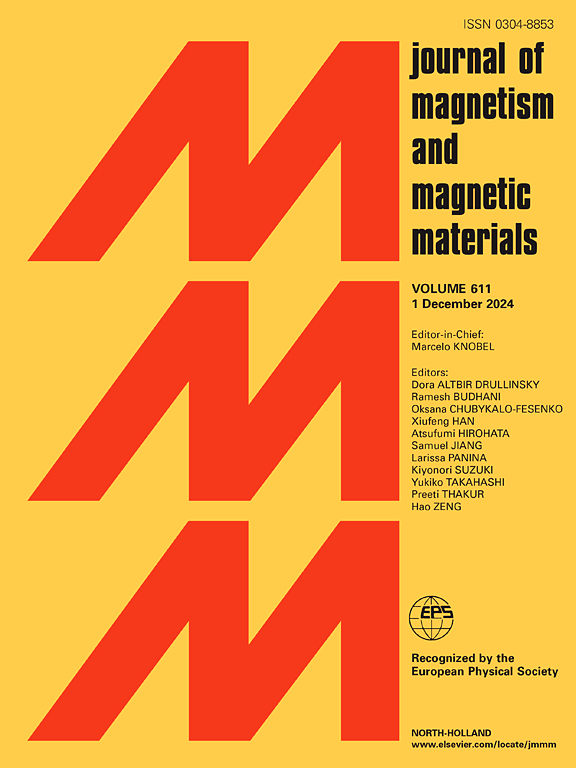ni掺杂ZnSe纳米粒子的结构、光学和磁性表征
IF 2.5
3区 材料科学
Q3 MATERIALS SCIENCE, MULTIDISCIPLINARY
引用次数: 0
摘要
研究了水热法制备的ZnSe和ni掺杂ZnSe纳米粒子的结构、光学和磁性表征。粉末x射线衍射(XRD)分析揭示了立方闪锌矿结构。表面形貌呈球状,具有团块结构。光学吸收截止波长为~ 445 nm,随着Ni掺杂的增加,该吸收增加。荧光研究显示在468,590和645 nm处的发射峰。荧光研究揭示了缺陷能级发射和近带边发射。振动样品磁强计(VSM)研究表明,由于合成样品中存在固有缺陷,纯净的和掺镍的ZnSe纳米颗粒表现出室温铁磁性(RTFM)。这些缺陷产生磁矩,从而产生铁磁性。在此基础上,对RTFM的产生机制进行了简要的探讨。具有可调谐磁性能的纯掺杂ZnSe纳米粒子是一种很有前途的自旋电子学材料。本文章由计算机程序翻译,如有差异,请以英文原文为准。
Structural, optical, and magnetic characterization of Ni-doped ZnSe nanoparticles
Structural, optical, and magnetic characterizations of ZnSe and Ni-doped ZnSe nanoparticles prepared by the hydrothermal route are investigated. The powder X-ray diffraction (XRD) analysis reveals the cubic zinc blende structure. The surface morphology shows a spherical shape with an agglomerated structure. The optical absorption cutoff wavelength is ∼ 445 nm, and this absorption increases with Ni doping. The fluorescence study reveals the emission peaks at 468, 590, and 645 nm. The fluorescence study reveals the defect-level emissions and the near-band-edge emission. The vibrating sample magnetometer (VSM) study shows that pure and Ni-doped ZnSe nanoparticles exhibit room temperature ferromagnetism (RTFM) due to the presence of intrinsic defects in the synthesized samples. These defects induce a magnetic moment, which leads to ferromagnetism. A brief discussion on the mechanism for the origin of RTFM is also presented based on the above results. The pure and Ni-doped ZnSe nanoparticles with tuned magnetic properties are promising materials for spintronics applications.
求助全文
通过发布文献求助,成功后即可免费获取论文全文。
去求助
来源期刊

Journal of Magnetism and Magnetic Materials
物理-材料科学:综合
CiteScore
5.30
自引率
11.10%
发文量
1149
审稿时长
59 days
期刊介绍:
The Journal of Magnetism and Magnetic Materials provides an important forum for the disclosure and discussion of original contributions covering the whole spectrum of topics, from basic magnetism to the technology and applications of magnetic materials. The journal encourages greater interaction between the basic and applied sub-disciplines of magnetism with comprehensive review articles, in addition to full-length contributions. In addition, other categories of contributions are welcome, including Critical Focused issues, Current Perspectives and Outreach to the General Public.
Main Categories:
Full-length articles:
Technically original research documents that report results of value to the communities that comprise the journal audience. The link between chemical, structural and microstructural properties on the one hand and magnetic properties on the other hand are encouraged.
In addition to general topics covering all areas of magnetism and magnetic materials, the full-length articles also include three sub-sections, focusing on Nanomagnetism, Spintronics and Applications.
The sub-section on Nanomagnetism contains articles on magnetic nanoparticles, nanowires, thin films, 2D materials and other nanoscale magnetic materials and their applications.
The sub-section on Spintronics contains articles on magnetoresistance, magnetoimpedance, magneto-optical phenomena, Micro-Electro-Mechanical Systems (MEMS), and other topics related to spin current control and magneto-transport phenomena. The sub-section on Applications display papers that focus on applications of magnetic materials. The applications need to show a connection to magnetism.
Review articles:
Review articles organize, clarify, and summarize existing major works in the areas covered by the Journal and provide comprehensive citations to the full spectrum of relevant literature.
 求助内容:
求助内容: 应助结果提醒方式:
应助结果提醒方式:


